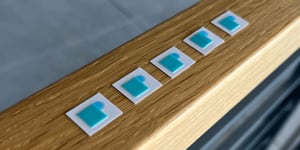Conductive adhesives are essential to fuel cell manufacturing, automotive, and consumer electronics.
Liquid epoxy and conductive transfer tape are both conductive adhesives, but they have their own advantages and disadvantages.
We’ll start by discussing electrically conductive materials and the two primary forms of conductive adhesive.
Electrically Conductive Material
Electrically conductive materials are often converted into conductive adhesive parts that hold devices together.
Devices using conductive adhesives include:
- Printed Circuit Boards (PCBs)
- Electronic monitors
- Flat cables
- Solar cell fabricating
- Flex chassis grounding
- EMI shield/gasket attachment
There are two main types of electrically conductive material: Liquid conductive epoxy and electrically conductive transfer tape.
LIQUID CONDUCTIVE EPOXY
Liquid conductive epoxy is made by adding conductive particles to resin or silicone.
Many small components are sensitive to high temperatures and can’t be fixed in place by soldering or welding. Heat damage, such as warping, ruins devices containing parts too delicate to withstand the indirect heat from filler materials.
Liquid conductive epoxy serves as an alternative to high-temperature solutions like soldering.
Besides helping avoid heat damage, liquid conductive epoxy can fill all the nooks and crannies of a cavity and ensure that every part of the device remains fixed in place.
Sadly, like everything else in life, there are downsides to using liquid conductive epoxy.
|
Pros |
Cons |
|
|
Applying liquid conductive epoxy is often a 3-step process:
First, mix the resin and a hardener.
Mixing can be somewhat of a messy process, and you have to do it with care, or else the epoxy itself won’t have the proper ratio of ingredients.
Next, apply the epoxy and wait for it to dry.
Without heat, you’ll be air-drying the epoxy, which takes far longer to set. Plus, the conductive particles in epoxy can migrate, which can cause devices to short out.
Even though epoxy enables you to control the level of conductivity, adding too many conductive particles could displace the resin and ultimately weaken the adhesive bond.
ELECTRICALLY CONDUCTIVE TRANSFER TAPE
Electrically conductive transfer tape is built by applying resin to a conductive material.
The placement and curing of electrically conductive transfer tape happen quickly because the rolls come ready for application.
Unlike liquid conductive epoxy, there’s no risk of mixing the adhesive wrong because it has already been applied to the material. Removing those steps decreases the chances of human error.
Manufacturers also use electrically conductive transfer tapes because they can provide EMI and RFI shielding and join into parts made from two different materials.
|
Pros |
Cons |
|
|
Electrically conductive transfer tape has a liner, making it thicker than the epoxy.
Epoxy is closer to the consistency of a liquid and spreads thinly, which is useful in electronics, but the liner of conductive transfer tape can provide extra stability.
Also, the conductive power of conductive transfer tape is generally lower than that of epoxy, depending on the strength of the epoxy used.
If your ideal solution involves reducing the application time and simplifying the process, die cut electrically conductive transfer tape is your best bet.
Epoxy vs. Transfer Tape
So far, you’ve read about epoxy and transfer tape, but you might not have decided just yet.
Let’s compare the two.
Epoxy is a viscous material that spreads thickly or thinly, but lacks the easy application of conductive transfer tapes with liners.
On the other hand, while electrically conductive transfer tape adhesive seeps into crevices as it sets, its composition is still much more solid than epoxy.
Epoxy can fill tight or complex spaces and doesn’t need cutting into a specific shape for the best possible use. However, epoxy takes significantly longer to set than conductive transfer tape.
Lastly, you can achieve a much higher rate of consistency when using electrically conductive transfer tape instead of epoxy.
Thanks to its conductive liner, the entire roll of tape can provide uniform conductivity levels. The power level isn’t as strong or customizable as a liquid conductive epoxy, but depending on the job, conductive transfer tape could be worth the reliability.
CONVERTING CONDUCTIVE MATERIALS
So, what kind of impact does this have on the converting process?
Converters mostly use electrically conductive transfer tape because it’s similar to the adhesives they usually run on their machines.
Electrically conductive transfer tape can be die cut into exact pieces and shapes for quicker and simpler applications.
Because it has an even distribution of adhesive, transfer tape also functions more consistently than epoxy, which is a huge benefit when you plan on scaling part production into the thousands or even millions!
If you’re interested in conductive adhesive parts, request a quote today so that we can help you get started.





